Papers by ANANDA KUMAR CHETTUPALLI
Materials Today: Proceedings
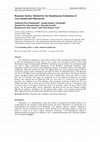
Trends in Sciences
The simultaneous estimation of Atorvastatin Calcium (ATS) and Olmesartan Medoxomil (OLM) in bulk ... more The simultaneous estimation of Atorvastatin Calcium (ATS) and Olmesartan Medoxomil (OLM) in bulk and pharmaceutical dosage forms, a new, quick, and cost-effective Reverse Phase High Performance Liquid Chromatography (RP-HPLC) method has been developed. The experimental design was used to achieve multivariate optimization of the RP-HPLC experimental conditions. Three independent variables were used to create mathematical models: Acetonitrile content in the mobile phase composition, buffer pH, and flow rate. Here, the applied model was central composite design (CCD) to research the response surface methodology and study the effects of independent factors. The Shimadzu (LC 20 AT VP) HPLC system with Spinchrom software has been used. Zodiac, C18 (250×4.6 ID) 5μm column, phosphate buffers, and acetonitrile were used as mobile phase in the ratio 40:60 v/v with a flow rate 1.15 mL/min. The eluent was monitored at 212 nm using the Prominence UV-Visible detector. The retention time for OLM a...

Anti-Cancer Agents in Medicinal Chemistry
: Cancer has a significant social consequence all around the globe. In 2020, approximately 193 la... more : Cancer has a significant social consequence all around the globe. In 2020, approximately 193 lakh new cases of cancer were diagnosed worldwide, with about 100 lakhs cancer deaths. In the next two decades, suspected cases are anticipated to increase by roughly 47%. The rising number of cancer patients, as well as the inadequacy of traditional chemotherapeutic agents, radiation, and invasive surgical procedures, all rely on massive cell death with hardly any selectivity, causing severe toxicities. In comparison to synthetic medications, there has subsequently been a surge in international importance in non-synthetic and alternative remedies, owing to improved adaptability and reduced side effects of drug responses. Several people with cancer prefer alternative and complementary therapy treatments, and natural remedies play a crucial role in cancer chemoprevention as they are thought to be harmless, offer fewer negative effects, and become less sufficient to evoke addiction by the wider population. Chemopreventive, anti-metastatic, cytotoxic, and anti-angiogenic actions are among the promising clinical advantages, which have been established in vitro research and certain clinical trials; nevertheless, additional clinical trials are needed. This review examines several phytochemicals that may have anti-cancer and chemopreventive properties.
Additional file 1: Fig. S1. In-vitro drug release profile for ethosomal formulations EF1-EF20. Fi... more Additional file 1: Fig. S1. In-vitro drug release profile for ethosomal formulations EF1-EF20. Fig. S2 A) Histogram showing the size distribution of ethosomal formulation EF1 B) Zeta potential of EF1. Fig. S3 In-vitro drug release profile of ethosomal gels G1-G7
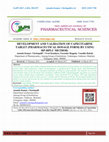
A new precise accurate and reliable validated method for the determination of Capecitabine was de... more A new precise accurate and reliable validated method for the determination of Capecitabine was developed by using reverse phase high performance liquid chromatography in pharmaceutical dosage forms. Spectrophotometer determination was carried out at an absorption maximum of 240nm by using methanol. The linearity was over the concentration range of 20-120 µg/ml with correlation coefficient 0.999. Chromatographic separation was carried out by using a mobile phase of methanol: Acetonitrile: water (80:20:80 V/V) on Waters 2487 dual absorbance column in an isocratic mode at a flow rate of 1.1 ml/min with UV detection at 240 nm. The developed methods were found to be precise and accurate for the estimation of Capecitabine in pharmaceutical dosage forms and could be used for routine analysis. Keywords: Capecitabine, RP-HPLC, Spectrophotometry, Waters 2487 dual absorbance detector, Nova pack 300 × 3.9mm 5μ as column, 240nm
Journal of Nanobiotechnology, 2021
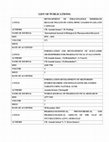
The purpose of this study was to prepare and evaluate immediate release itraconazole pellets and ... more The purpose of this study was to prepare and evaluate immediate release itraconazole pellets and comprehensive studies of the same. The itraconazole pellets is prepared using fluid bed processer with different concentration of HPMC (Hydroxy Propyl Methyl Cellulose). The physicochemical compatibility of the drug and the excipient studied by differential scanning calorimetry. The prepared pellets were physically evaluated with size, shape, bulk density, tapped density, compressibility index, hausners ratio, angle of repose, sieve analysis, surface roughness, density, moisture content, assay and drug release etc. The in vitro drug release profile from pellets shows that all the formulation release more than 75% drug within 90min. Optimized formulations were found to have HPMC concentration 2-5% of total weight of pellets to maximize high- quality surface, desired release, and size distribution within the range. These results indicate that pellets containing 10 % HPMC of total weight of...
Journal of Dermatological Science, 2013

CNS & Neurological Disorders - Drug Targets
: Herbal medicines are being used by humans since the oldest civilizations and have been an integ... more : Herbal medicines are being used by humans since the oldest civilizations and have been an integral part of traditional and alternative medicines. In recent times, pharmaceutical and biomedical scientists are taking interest in developing nutraceutical-based medicines to overcome the side effects and adverse drug reactions caused by allopathic medicines. Nutraceuticals have started occupying the global market. Nutraceuticals have gained widespread acceptance due to their efficacy in treating difficult to treat diseases, low toxicity, low cost, easy accessibility, etc. Safety and efficacy are other important factors in the commercialization process of nutraceuticals. Different novel advanced drug delivery systems have been constantly studied to improve the efficacy and bioavailability of medicines obtained from herbal sources. The transdermal drug delivery system provides a potent alternative to the conventional method of using nutraceuticals. The development of transdermal system-based nutraceuticals could provide the advantage of enhanced bioavailability, improved solubility, bypass of the first-pass metabolism, and targeted delivery of drugs in brain-related disorders. It additionally provides the advantage of being non-invasive. This article reviews the potential effects of various nutraceuticals in brain-related disorders as well as trends in transdermal nano-systems to deliver such nutraceuticals. We have also focused on advantages, applications as well as recent United States-based patents which emphasize emerging interest towards transdermal nutraceuticals in brain disorders.

The cause of ulceration in patients is mainly due to hyper secretion of gastric juice and also du... more The cause of ulceration in patients is mainly due to hyper secretion of gastric juice and also due to hyper secretion of pepsin. In traditional system of medicine a number of herbal preparations have been used for the treatment of peptic ulcers. There are various medicinal plants has been used for the treatment of gastrointestinal disorders. In view of this, in present study we have to evaluate the anti-ulcer activity of parathenium hysterophorus. Study was carried out, by using three methods i.e., alcohol, paracetamol and stress induced ulcers in rats pretreated with the doses of 250 mg/kg AQPH and ALPH, 20mg/kg Omeoprazole and 50 mg/kg Ranitidine. To evaluate the antiulcer activity of aqueous and alcoholic extracts of parathenium hysterophorus leaves (AQPH and ALPH) at 250 doses using different experimentally induced gastric ulcer models in rats. Gastric ulcers were induced in rats by 80% alcohol, paracetamol and forced immersion stress induced methods. In alcohol induced ulcer mo...
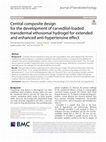
Journal of Nanobiotechnology
Background Carvedilol, the anti-hypertensive drug, has poor bioavailability when administered ora... more Background Carvedilol, the anti-hypertensive drug, has poor bioavailability when administered orally. Ethosomes-mediated transdermal delivery is considered a potential route of administration to increase the bioavailability of carvedilol. The central composite design could be used as a tool to optimize ethosomal formulation. Thus, this study aims to optimize carvedilol-loaded ethosomes using central composite design, followed by incorporation of synthesized ethosomes into hydrogels for transdermal delivery of carvedilol. Results The optimized carvedilol-loaded ethosomes were spherical in shape. The optimized ethosomes had mean particle size of 130 ± 1.72 nm, entrapment efficiency of 99.12 ± 2.96%, cumulative drug release of 97.89 ± 3.7%, zeta potential of − 31 ± 1.8 mV, and polydispersity index of 0.230 ± 0.03. The in-vitro drug release showed sustained release of carvedilol from ethosomes and ethosomal hydrogel. Compared to free carvedilol-loaded hydrogel, the ethosomal gel showed ...

Proceedings of MOL2NET 2018, International Conference on Multidisciplinary Sciences, 4th edition
The current study entails novel advanced formulation approach binary ethosomal gel containing Car... more The current study entails novel advanced formulation approach binary ethosomal gel containing Carvedilol and evaluating the optimized formulation for hypertension. Carvedilol is an antihypertensive agent, which undergoes hepatic metabolism and shows poor bioavailability of just 20 %. Carvedilol binary ethosomal suspension was optimized using central composite design (CCD). In which quantities of lipid (A), ethanol (b), and propylene glycol (C) were selected independent variables; vesicle size (Y1), entrapment efficiency (Y2) and cumulative %drug release (Y3) were selected as dependent variables. The composition of optimum formulation was found as 2 % of lipid (Soya lecithin), 20 % of ethanol, and 10 % of propylene glycol. The optimized binary ethosomal suspension (OBE) had shown a vesicle size, poly dispersable index, ztapotential, cumulative % drug release, and %entrapment efficiency of 130±1.72nm, 0.230±0.03,-31±1.8MV, 97.89±3.7 %, and 99±2.96 % respectively. This was further evaluated and compared with liposomes. Scanning electron microscopy studies revealed that OBE was in spherical shape. The OBE was converted to hydrogel and evaluated for rheological properties. The OBE-Gel (OBE-G) attained mean transdermal flux of 0.0644±0.002 mg/cm 2 .h through rat skin. This formulation showed a substantial and constant decrease SciForum in blood pressure, for up to 24 h. The OBE-G was found to be effective, with reduction in blood pressure by virtue of better permeation through rat skin. In conclusion, OBE-G accentuate the transdermal flux and the results obtained encouraged its use for hypertension treatment.
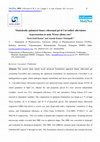
Proceedings of MOL2NET 2018, International Conference on Multidisciplinary Sciences, 4th edition, Oct 27, 2018
The current study entails novel advanced formulation approach binary ethosomal gel containing Car... more The current study entails novel advanced formulation approach binary ethosomal gel containing Carvedilol and evaluating the optimized formulation for hypertension. Carvedilol is an antihypertensive agent, which undergoes hepatic metabolism and shows poor bioavailability of just 20 %. Carvedilol binary ethosomal suspension was optimized using central composite design (CCD). In which quantities of lipid (A), ethanol (b), and propylene glycol (C) were selected independent variables; vesicle size (Y1), entrapment efficiency (Y2) and cumulative %drug release (Y3) were selected as dependent variables. The composition of optimum formulation was found as 2 % of lipid (Soya lecithin), 20 % of ethanol, and 10 % of propylene glycol. The optimized binary ethosomal suspension (OBE) had shown a vesicle size, poly dispersable index, ztapotential, cumulative % drug release, and %entrapment efficiency of 130±1.72nm, 0.230±0.03,-31±1.8MV, 97.89±3.7 %, and 99±2.96 % respectively. This was further evaluated and compared with liposomes. Scanning electron microscopy studies revealed that OBE was in spherical shape. The OBE was converted to hydrogel and evaluated for rheological properties. The OBE-Gel (OBE-G) attained mean transdermal flux of 0.0644±0.002 mg/cm 2 .h through rat skin. This formulation showed a substantial and constant decrease SciForum in blood pressure, for up to 24 h. The OBE-G was found to be effective, with reduction in blood pressure by virtue of better permeation through rat skin. In conclusion, OBE-G accentuate the transdermal flux and the results obtained encouraged its use for hypertension treatment.
Carvedilol is useful in the treatment of stable, unstable angina and myocardial infarction. Insta... more Carvedilol is useful in the treatment of stable, unstable angina and myocardial infarction. Instable angina it demonstrated to reduce ischemic attacks and to improve threshold of chest pain; in a compared study with verapamil, Carvedilol showed similar effect on symptoms and ECG alterations. [21] Respect to metaprolol SJIF Impact Factor 4.161

Glyburide belongs to class II drugs, that is, characterized by low solubility and high permeabili... more Glyburide belongs to class II drugs, that is, characterized by low solubility and high permeability therefore, the enhancement of its solubility and dissolution profile is expected to significantly improve its bioavailability and reduce its side effects. The precompression blend of Glyburide soild dispersions were characterized with respect to angle of repose, bulk density, tapped density, Carr's index and Hausner's ratio. The precompression blend of all the batches indicates well to fair flow ability and compressibility. Solid dispersions were prepared with various concentrations of carriers; the prepared solid dispersions were compressed into tablets. The formulated tablets were evaluated for various quality control parameters. The tablets were passed all the tests. Among all the formulations F2 formulation containing, Drug and β cyclodextrin in the ratio of 1:2 showed good result that is 97.06 % in 20 minutes. Hence from the dissolution data it was evident that F2 formulation is the better formulation. By conducting further studies like Invivo studies, preclinical and clinical studies we can commercialize the product.

Innovare Journal of Ayurvedic Sciences, Mar 11, 2014
Skin acts as a major target as well as a principal barrier for topical/transdermal drug delivery.... more Skin acts as a major target as well as a principal barrier for topical/transdermal drug delivery. Despite the many advantages of this system, the major obstacle is the low diffusion rate of drugs across the stratum corneum. Several methods have been tried to increase the permeation rate of drugs temporarily. One simple and convenient approach is application of drugs in formulation with elastic vesicles or skin enhancers. Vesicular system is one of the most convenient methods for transdermal delivery of active substances and in that ethosomes are most useful vesicular systems. Ethosomal carriers are systems containing soft vesicles, composed of hydroalcoholic or hydro/glycolic phospholipid in which the concentration of alcohols is relatively high. The high concentration of ethanol brings increase in fluidity of lipids hence increase in permeability of the skin and improves the drug penetration. Ethosomal formulation may contain many drugs such as acyclovir, salbutamol, Insulin, cyclosporine, fluconazole, minodixil, etc. These are prepared by hot method and cold methods. The size of Ethosomal formulation can be decreased by sonication and extrusion method. The high concentration of ethanol makes the ethosomes unique and useful for transcellular delivery, delivery of hormones, anti-arthritis, anti-HIV etc. Thus, it can be a logical conclusion that ethosomal formulation possesses promising future in effective dermal/transdermal delivery of bioactive agents











Uploads
Papers by ANANDA KUMAR CHETTUPALLI